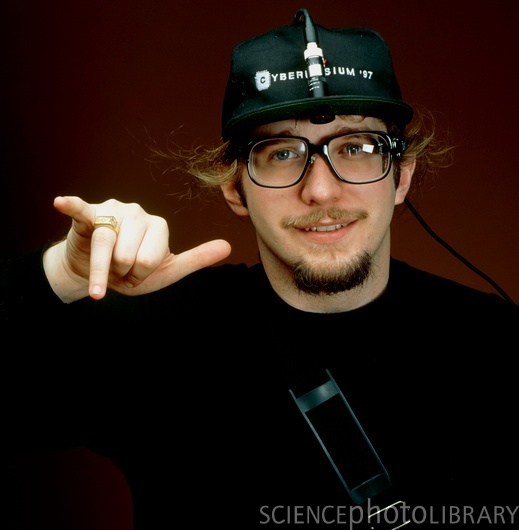Thad Starner's wearable computer
"Thad Starner: My interest in wearable computing was purely self-motivated. I was going to MIT as an undergraduate and spending – I guess back then it was only $20,000 a year, and now it's much more – quite a lot of money on my education … and I was discovering that I wasn't remembering any of it.
Either I could pay attention in class to what the lecturer was saying and get some intuition about what was going on, or I could spend all my effort on writing notes. But I could not do both. So if I spent time paying attention to the lecturer, I would remember it for about two hours and feel like I actually understood the material. But after two hours, I couldn't remember a thing. If I spent time writing it down, I got no intuition. I got the material down off the whiteboard, but it meant nothing to me. And my handwriting was so bad that I even lost that after two weeks. I couldn't read my own notes.
So I was thinking, "Why am I spending all this money on my education when I'm not getting anything from it?" Of course, a lot of education is problem solving. But I really saw the desire to remember these lectures and actually use my information in my daily life as a scientist.
The other thing I discovered was that most of my education was not coming from classes. It was coming from face-to-face conversations with the researchers, the grad students and professors that I met in the hallway, or working on my projects.
So I was convinced to design a system so that I could actually pay attention in class and take good notes, as well as take notes during these important face-to-face conversations. So whenever somebody says something interesting, I can get it down unobtrusively, quickly, and actually then reuse those notes later on in further conversations.
That's why I made a wearable computer. I started out with a laptop. A laptop of course doesn't work when you're walking around, and it also doesn't work well in a classroom. It turned out that having the laptop screen close to me meant that I was changing the physical focus of my eyes from very near (the laptop display) to very far for the whiteboard. That process took too much time. And even though I could type much faster than I could write, the change of physical focus slowed me down too much. I found a laptop couldn't do it.
So I went to a heads-up display. I could put the focus on the whiteboard, and suddenly I could keep up. And I found not only could I keep up and take good notes, especially with this one-handed Twiddler keyboard I have, but it actually focused my mental attention, so that during a lecture I got a whole lot more out of it than ever before. And that's why if you've ever seen me in a meeting or a lecture, you'll see me taking notes furiously on my wearable computer not just so I get it, but also because it keeps my attention focused. I can put in new ideas and new offshoots and things I want to ask later into the stream of data that I'm capturing" [1]
